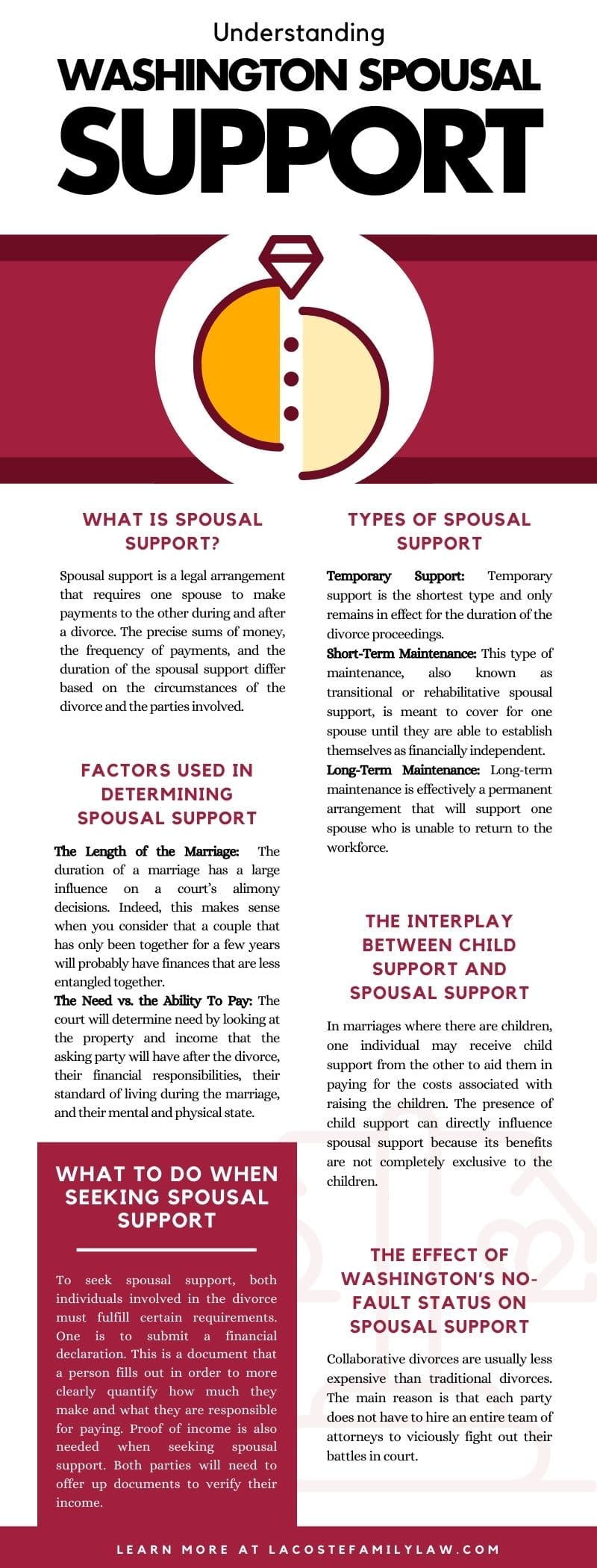
22 Apr Understanding Washington Spousal Support
Due to the fact that most couples share finances during a marriage, each spouse may not always generate income equally. Should they undergo a divorce, it is possible that one person can be left destitute while the other is economically stable. This is why spousal support, otherwise known as alimony, exists. It helps to ensure that both parties walk away from a marriage with the ability to sustain themselves. Gain an understanding of Washington spousal support with the information that we provide in this post.
What Is Spousal Support?
Spousal support is a legal arrangement that requires one spouse to make payments to the other during and after a divorce. The precise sums of money, the frequency of payments, and the duration of the spousal support differ based on the circumstances of the divorce and the parties involved.
Types of Spousal Support
A few types of spousal support exist in the state of Washington, mostly defined by how long they last. Here are brief descriptions for each:
- Temporary Support: Temporary support is the shortest type and only remains in effect for the duration of the divorce proceedings. Through it, one spouse must pay the other to cover legal fees and help them meet their financial needs.
- Short-Term Maintenance: This type of maintenance, also known as transitional or rehabilitative spousal support, is meant to cover for one spouse until they are able to establish themselves as financially independent. It can help them get the education or training they need to enter a stable career after having been unemployed for a long time. Short-term maintenance is often deemed necessary when one spouse has stayed at home to focus on raising children.
- Long-Term Maintenance: Long-term maintenance is effectively a permanent arrangement that will support one spouse who is unable to return to the workforce. This could be due to old age or an infirmity. Given the nature of these reasons, long-term maintenance is usually only seen with marriages that lasted for long periods.
Factors Used in Determining Spousal Support
So, what factors does the court use to determine the nature of spousal support? The answer is a complex one, but the following are some major considerations that it will usually make.
The Length of the Marriage
As hinted at when speaking about the types of spousal support, the duration of a marriage has a large influence on a court’s alimony decisions. Indeed, this makes sense when you consider that a couple that has only been together for a few years will probably have finances that are less entangled together. Mirroring the spousal support types, there are three duration categories that result in certain patterns regarding the financial awards that the court determines:
- Short-term Marriages: These are marriages that lasted for up to five years. Short-term marriages will usually limit spousal support to minimal amounts and short periods.
- Mid-term Marriages: Mid-term marriages are those that extended anywhere between five to twenty-five years. It is difficult to predict the spousal support for marriages that fall within this category, as they can vary greatly based on other factors.
- Long-term Marriages: Long-term marriages have endured for more than twenty-five years and are frequently tied with long-term maintenance when a divorce occurs.
The Need vs. the Ability to Pay
The potential recipient spouse’s need and the other spouse’s ability to pay are also key factors that a judge will think about and become some of the main considerations for mid-term marriages. The court will determine need by looking at the property and income that the asking party will have after the divorce, their financial responsibilities, their standard of living during the marriage, and their mental and physical state. Time required for education and training can also play a part in defining need. It will determine the other party’s ability to pay by looking at their financial obligations, as well as their income and property.
The Interplay Between Child Support and Spousal Support
In marriages where there are children, one individual may receive child support from the other to aid them in paying for the costs associated with raising the children. The presence of child support can directly influence spousal support because its benefits are not completely exclusive to the children. That money could go towards financing common things, such as household utilities. The court will acknowledge this, and as a result, if a parent is already receiving child support, the extent of their spousal support may correspondingly decrease.
The Effect of Washington’s No-Fault Status on Spousal Support
Washington is a no-fault divorce state, a fact that is important in understanding Washington spousal support. What this means is that courts will not reflect on which spouse caused the divorce. Since Washington law states that courts cannot consider “misconduct” in determining spousal support, people often think this means all wrongs. However, besides causing a divorce, other actions are still subject to legal scrutiny. Therefore, a court in Washington will not lower spousal support if the recipient was the one who instigated the divorce, as other states may do. If a spouse purposely decreases their income so that they are less capable of paying alimony or either spouse carries out some other wrongdoing, though, spousal support can change.
What to Do When Seeking Spousal Support
To seek spousal support, both individuals involved in the divorce must fulfill certain requirements. One is to submit a financial declaration. This is a document that a person fills out in order to more clearly quantify how much they make and what they are responsible for paying. Financial declarations make it easier for courts to elucidate the need of one spouse and the other’s ability to pay. Proof of income is also needed when seeking spousal support. Both parties will need to offer up documents to verify their income. These may be recent pay stubs or tax returns.
How to Fight Against Paying Spousal Support
When your spouse is seeking alimony from you, there are ways to fight against them as well. Showing that their income is higher and that their expenses are lower than they portray through the financial declaration will greatly help your case. Simultaneously, you should try to show that your income is not as high as your spouse wants to make it seem and that your expenses are relatively high. You should also remember that falsifying or holding back information on the financial declaration is legally considered a wrongdoing. Therefore, you must remain truthful and aim to point out inconsistencies in your spouse’s declaration if they exist. Making the court aware of large assets that your spouse has can also aid your defense.
It may also be useful to scrutinize the preconceptions that spousal support is based on. Alimony assumes that one spouse makes more money in a marriage while the other devotes their time to caring for the family. However, your marriage may not have fitted this mold. When both partners in a marriage have remained in active careers or you raised the children at home while also bringing in the larger income, you may be able to fight off or reduce spousal support.
Ultimately, no matter which side you fall on in a divorce, you will need a skilled legal professional to guide you and build your case in court. Call LaCoste Family Law today for a spousal support attorney in Washington state who will help you attain a just ruling.


